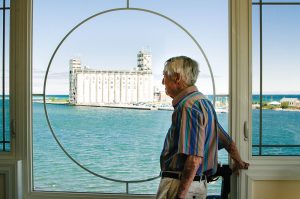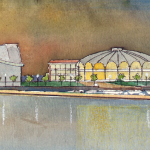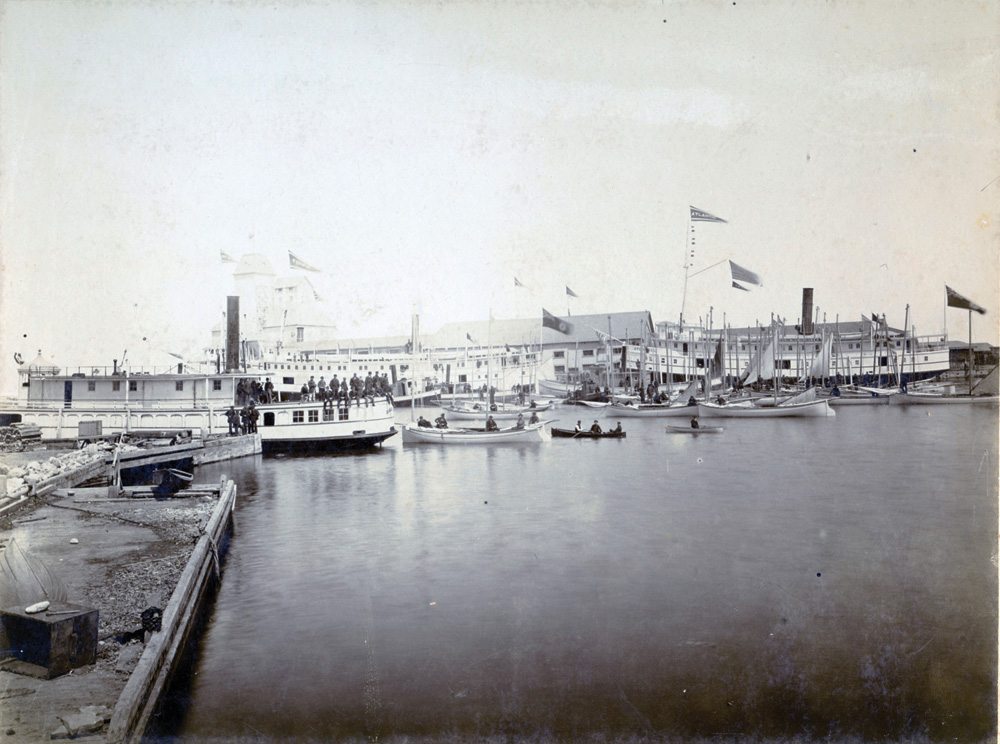Gateway to the past, or white elephant? One man’s viewpoint.
by Janet Lees
photography by Jessica Crandlemire

The view from the third-floor office in John Wiggins’ Shipyards condo is enviable: a perfect panorama of Collingwood’s waterfront, with the Collingwood Terminals grain elevator framed squarely in the centre of the north window’s circular porthole motif.
The iconic structure stands like a sentry at the entrance to Collingwood Harbour, harkening back to the days when Collingwood was a thriving shipping port known as the “Chicago of the North.” Lit up at night, the façade’s ethereal glow conjures the ghosts of the thousands who toiled in its shadow during Collingwood’s 100-year shipbuilding heyday.
It is arguably our region’s most recognizable and beloved landmark. Yet far from relishing the sight, Wiggins looks out his window at the Terminals building and dreams of tearing it down.
“As far as I’m concerned, that little piece of land out there, which I call Harbour Island and everybody else calls The Spit, has that big hunk of concrete on it that’s doing absolutely nothing – it doesn’t pay taxes, and it’s kind of in the way of a huge opportunity,” explains Wiggins. “Unfortunately, everyone’s in love with it, so whenever I mention knocking it down they want to hang me from the nearest tree.”
Wiggins’ vision for the property includes demolishing the Terminals building, using the rubble to expand the Millennium Park property on the water side of the Terminals, and developing a “very meaningful, world-class” arts and convention centre on the land.
“I see the possibility of becoming an Aspen or a Banff of the east,” says Wiggins. “It’s a gem of a property and how do you turn that into something very significant? The challenge is getting people over the hurdle of what it could be and how important it could be in the future.”
A former ad designer and the retired founder of Creemore Springs Brewery, Wiggins has created a conceptual drawing of what he envisions on the property: a hotel, conference centre, performing arts theatre, sound studio, rehearsal hall and artist’s studios, with underground parking beneath the complex.
“I think if you put together what I’m talking about, there could be a million dollars worth of taxes each year instead of costing the town money,” says Wiggins, noting that the town owns the building and property. However, he admits the idea will be a “tough sell” – the historic significance of the building and the fact that it is within the Collingwood Downtown Heritage Conservation District mean that any proposal to demolish or significantly change the structure would likely meet with fierce opposition.
Wiggins’ idea is just the latest in a long line of uses that have been suggested for the Terminals and surrounding land. In the late ’90s, a local engineering firm proposed “The Collingwood Aerial” – a gondola that would take visitors from the grain elevators to downtown Collingwood and all the way to Blue Mountain. In 2012, a pair of local residents proposed turning the elevators into a specialty mushroom farm. Other ideas floated over the years have included an office building, art gallery, marine museum, youth centre, sports facility, resort, cruise ship terminal, restaurant, shops and services, hotel, and condominiums.
In the few instances where an idea went beyond the conceptual stage, it fell by the wayside once the proponents realized the enormous cost involved in modernizing and converting a massive building with no water, sewer or electrical servicing, with cement walls several feet thick and reinforced with rebar.
Dean Collver, Collingwood’s director of parks, recreation and culture, recently met with Wiggins to discuss his idea and says he was impressed by Wiggins’ interest and effort, calling his plan “ambitious.” However, he adds the town’s Waterfront Master Plan (WMP), which has been adopted by council and does not currently contain any proposals relating to the Terminals, will likely take precedence over other plans and proposals for at least the near future.
“The WMP was an intensive 11-month project that made over 2,000 points of contact with community members along the way. Additionally, it established an estimated $50-million project scope that we are just beginning to navigate,” notes Collver. “John’s concept is, by his own admission, a significant addition to that scope. I definitely applaud his enthusiasm and vision, though, and would not want to deter him from his own efforts to move it forward, if it is feasible to do so.”
He adds the building’s designation as part of the Heritage Conservation District would make such a project especially challenging. “It would be a difficult and extensive process to have it removed from designation prior to any consideration of demolition.”
The Terminals building is currently undergoing an engineering assessment to evaluate the soundness of the structure and any repairs that may be required. “This could be considered the first step in developing a longer-term outlook for the building,” says Collver.
For his part, Wiggins says he is still at the research stage and hopes to get others behind his concept or something similar to move it forward. “I see myself as a catalyst,” he says, adding, “It’s not against the terminals; it’s about what could be there and making the most out of a jewel of a piece of property.” ❧
















